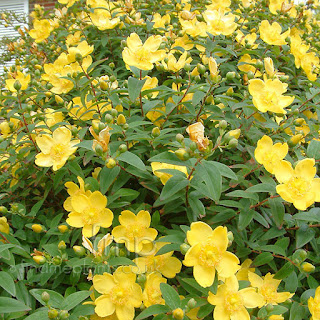Last week, I decided to change my grass lawn for a drought resistant ground cover. I did some research on ground covers that thrives well in our area. I decided on Hypericum calycinum commonly known as St John Worth or Aaron Beard. Above is a photo of my lawn new planting. I hope that in a years time it would look like the photo below. The culture of Hypericum is also listed below.
Culture
Easily
grown in average, medium, well-drained soil in full sun to part shade.
Tolerates wide range of soils. Thrives on sandy soils in full sun. Less
floriferous in part shade. Evergreen in warm winter climates. Usually
dies to the ground or suffers some tip dieback in cold winter climates,
but blooms on new growth and comes back nicely each spring. In areas
where it does not die in winter, shear or mow plants in late winter or
early spring every 2-3 years to renew and induce new growth. Spreads
rapidly by underground stems and can spread aggressively in ideal
growing conditions. Plant 18" apart for use as a ground cover.
Noteworthy Characteristics
A
stoloniferous subshrub or shrublet, typically growing 12" (less
frequently to 18") high and 24" wide, which is frequently planted as a
ground cover. Features large, rose-like, 5-petaled, yellow flowers (2-3"
diameter) having numerous, bushy stamens with reddish anthers. Flowers
appear singly or in groups of 2-3 and cover the plant in summer. Oval to
oblong, distinctively net-veined (from beneath) leaves (to 4" long) are
rich green in sun but are a lighter, yellowish green in shade.
Four-angled stems are both procumbent and ascending. Sometimes commonly
called Aaron's beard or creeping St. John's wort. Plants of the genus Hypericum (some
species have been used since ancient times in the treatment of wounds)
were apparently gathered and burned to ward off evil spirits on the eve
of St. John's Day, thus giving rise to the genus common name of St.
John's wort.


Wow! I am very impressed with the landscaping job you have done, it is beyond gorgeous and you should be very proud of yourself. It is almost like you have a natural green thumb. Perhaps I can hire your services sometime to work on my yard, if you are at all interested.
ReplyDeleteGladis Livingston @ HDS Landscaping